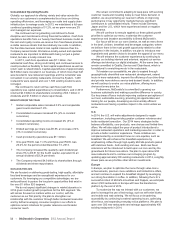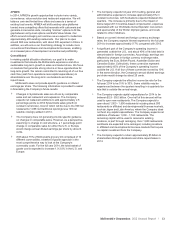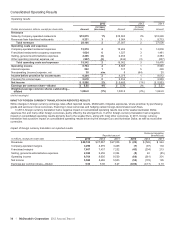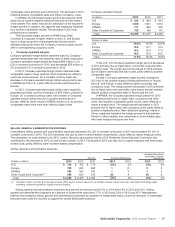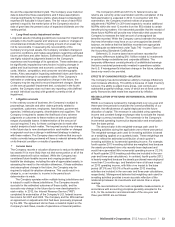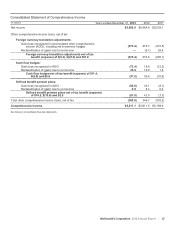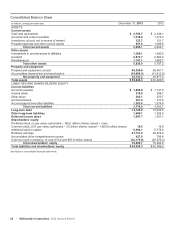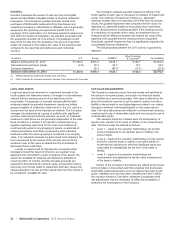McDonalds 2013 Annual Report Download - page 30
Download and view the complete annual report
Please find page 30 of the 2013 McDonalds annual report below. You can navigate through the pages in the report by either clicking on the pages listed below, or by using the keyword search tool below to find specific information within the annual report.
22 | McDonald’s Corporation 2013 Annual Report
and will continue to make, substantial investments to support the
ongoing development and growth of our international operations.
Accordingly, no U.S. federal or state income taxes have been
provided on these undistributed foreign earnings. The Company's
cash and equivalents held by our foreign subsidiaries totaled
approximately $2.0 billion as of December 31, 2013. We do not
intend, nor do we foresee a need, to repatriate these funds.
Consistent with prior years, we expect existing domestic cash
and equivalents, domestic cash flows from operations, annual
repatriation of a portion of the current period's foreign earnings,
and the issuance of domestic debt to continue to be sufficient to
fund our domestic operating, investing, and financing activities.
We also continue to expect existing foreign cash and equivalents
and foreign cash flows from operations to be sufficient to fund our
foreign operating, investing, and financing activities.
In the future, should we require more capital to fund activities
in the U.S. than is generated by our domestic operations and is
available through the issuance of domestic debt, we could elect to
repatriate a greater portion of future periods' earnings from foreign
jurisdictions. This could also result in a higher effective tax rate in
the future.
While the likelihood is remote, to the extent foreign cash is
available, the Company could also elect to repatriate earnings
from foreign jurisdictions that have previously been considered to
be indefinitely reinvested. Upon distribution of those earnings in
the form of dividends or otherwise, the Company may be subject
to additional U.S. income taxes (net of an adjustment for foreign
tax credits), which could result in a use of cash. This could also
result in a higher effective tax rate in the period in which such a
determination is made to repatriate prior period foreign earnings.
Refer to the Income Taxes note to the consolidated financial
statements for further information related to our income taxes and
the undistributed earnings of the Company's foreign subsidiaries.
CONTRACTUAL OBLIGATIONS AND COMMITMENTS
The Company has long-term contractual obligations primarily in
the form of lease obligations (related to both Company-operated
and franchised restaurants) and debt obligations. In addition, the
Company has long-term revenue and cash flow streams that
relate to its franchise arrangements. Cash provided by operations
(including cash provided by these franchise arrangements) along
with the Company’s borrowing capacity and other sources of cash
will be used to satisfy the obligations. The following table
summarizes the Company’s contractual obligations and their
aggregate maturities as well as future minimum rent payments
due to the Company under existing franchise arrangements as of
December 31, 2013. See discussions of cash flows and financial
position and capital resources as well as the Notes to the
consolidated financial statements for further details.
Contractual cash outflows Contractual cash inflows
In millions Operating
leases
Debt
obligations(1) Minimum rent under
franchise arrangements
2014 $ 1,440 $ 2,703
2015 1,334 $ 1,199 2,612
2016 1,218 2,095 2,507
2017 1,099 1,054 2,377
2018 990 1,004 2,260
Thereafter 7,632 8,765 18,042
Total $13,713 $14,117 $30,501
(1) The maturities reflect reclassifications of short-term obligations to long-
term obligations of $1.2 billion, as they are supported by a long-term line
of credit agreement expiring in November 2016. Debt obligations do not
include $13 million of noncash fair value hedging adjustments or $222
million of accrued interest.
In the U.S., the Company maintains certain supplemental
benefit plans that allow participants to (i) make tax-deferred
contributions and (ii) receive Company-provided allocations that
cannot be made under the qualified benefit plans because of
Internal Revenue Service ("IRS") limitations. At December 31,
2013, total liabilities for the supplemental plans were $531 million.
In addition, total liabilities for gross unrecognized tax benefits
were $513 million at December 31, 2013.
There are certain purchase commitments that are not
recognized in the consolidated financial statements and are
primarily related to construction, inventory, energy, marketing and
other service related arrangements that occur in the normal
course of business. The amounts related to these commitments
are not significant to the Company’s financial position. Such
commitments are generally shorter term in nature and will be
funded from operating cash flows.
Other Matters
CRITICAL ACCOUNTING POLICIES AND ESTIMATES
Management’s discussion and analysis of financial condition and
results of operations is based upon the Company’s consolidated
financial statements, which have been prepared in accordance
with accounting principles generally accepted in the U.S. The
preparation of these financial statements requires the Company to
make estimates and judgments that affect the reported amounts of
assets, liabilities, revenues and expenses as well as related
disclosures. On an ongoing basis, the Company evaluates its
estimates and judgments based on historical experience and
various other factors that are believed to be reasonable under the
circumstances. Actual results may differ from these estimates
under various assumptions or conditions.
The Company reviews its financial reporting and disclosure
practices and accounting policies quarterly to ensure that they
provide accurate and transparent information relative to the
current economic and business environment. The Company
believes that of its significant accounting policies, the following
involve a higher degree of judgment and/or complexity:
Property and equipment
Property and equipment are depreciated or amortized on a
straight-line basis over their useful lives based on management’s
estimates of the period over which the assets will generate
revenue (not to exceed lease term plus options for leased
property). The useful lives are estimated based on historical
experience with similar assets, taking into account anticipated
technological or other changes. The Company periodically reviews
these lives relative to physical factors, economic factors and
industry trends. If there are changes in the planned use of
property and equipment, or if technological changes occur more
rapidly than anticipated, the useful lives assigned to these assets
may need to be shortened, resulting in the accelerated recognition
of depreciation and amortization expense or write-offs in future
periods.
Share-based compensation
The Company has a share-based compensation plan which
authorizes the granting of various equity-based incentives
including stock options and restricted stock units ("RSUs") to
employees and nonemployee directors. The expense for these
equity-based incentives is based on their fair value at date of grant
and generally amortized over their vesting period.
The fair value of each stock option granted is estimated on
the date of grant using a closed-form pricing model. The pricing
model requires assumptions, which impact the assumed fair value,
including the expected life of the stock option, the risk-free interest
rate, expected volatility of the Company’s stock over the expected


